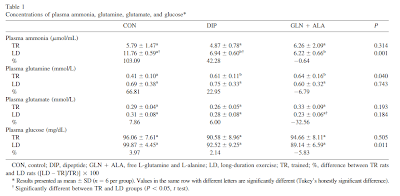Glutamine: Alanyl-Glutamine or L-Alanine + L-Glutamine - Is There a Difference?
Some athletes, mostly bodybuilders, swear by it, yet the results of studies on the ergogenic effect of l-glutamine supplementation are quite unequivocal. A recent study (Petry. 2010) investigated the effect of alanyl-glutamine (DIP, at 1.5 g/kg, n=8), L-glutamine + L-alanine (GLN+ALA, at 1 and 0.61 g/kg, respectively; n=8) or water (CONTR, n=8) supplementation on various exercise-related parameters in rats after 21 days of training. The results are promising, yet far from earth-shattering:
While these results appear similar to those of a study by Cruzat and Tirapegui (Cruzat & Tirapegui. 2009), the individual values listed in Table 2 (below, Cruzat & Tirapegui. 2009) are somewhat different. Cruzat & Tirapegui, for example, were able to show that l-glutamine + l-alanine was actually able to reverse the exercise-induced release of muscle glutamine and glutamate. The positive effect on blood ammonia of supplementation of individual amino acids was superior to the one following alanyl-glutamine-dipeptide, as well.
Therefore, it seems counter-intuitive to look for probably overpriced alanyl-glutamine supplements if bulk L-glutamine and L-alanine powders are readily available. Whether a higher dose of glutamine, i.e. >1g/kg, as it is commonly recommended by body-building "gurus", would facilitate a further increase in muscle glutamine levels has yet to be investigated, because as Mauro Di Pasquale in his Amino Acid Bible, Amino Acids and Proteins fot the Athlete: The Anabolic Edge, underlines:
"Supplementation with DIP or GLN+ALA increased plasma glutamine concentration by 23% and 21% respectively, as compared to CONTR group (p<0.0001). Plasma ammonia concentration was lower in both supplemented groups (DIP, 3.8 ± 0.1 μM and GLN+ALA, 4.1 ± 0.2 μM), compared with CONTR group (5.3 ± 0.2 μM) (p<0.0001). DIP and GLN+ALA groups exhibited in the soleus muscle high glutamine (33.4% and 28%), glutamate (21.7% and 10.8%) and glutathione (GSH, 52.2% and 48.4%), compared to controls. In the gastrocnemius muscle also more glutamine (42.6 and 24.8%), glutamate (10.2 and 13.1%) and GSH (51.3 and 47.2%) were observed, compared to controls. In the liver of the supplemented groups high concentration of glutamine (36.9% and 32.7%), glutamate (4.6% and 2.8%) and GSH (47.1% and 46.4%) were observed. Plasma concentration of malondialdehyde (MDA), an index of plasma lipoperoxidation, was lower in both nutritional treatments (DIP 46.6% and GLN+ALA, 37.6%). Additionally, lower activity of plasma creatine kinase (CK) was observed in the DIP (25.1%) and GLN+ALA (24.3%) groups, as compared to controls, which was in paralleled by a marked decrease in the liberation of muscle myoglobin towards in the plasma (DIP, 43.9% and GLN+ALA, 35.3%).What is of particular interest is the slightly superior effect of the alanyl-glutamine molecule as compared to the supplementation of L-alanine and L-glutamin on the glutamin-levels of muscle and liver and the slightly greater decrease in muscle myoglobin liberation.
While these results appear similar to those of a study by Cruzat and Tirapegui (Cruzat & Tirapegui. 2009), the individual values listed in Table 2 (below, Cruzat & Tirapegui. 2009) are somewhat different. Cruzat & Tirapegui, for example, were able to show that l-glutamine + l-alanine was actually able to reverse the exercise-induced release of muscle glutamine and glutamate. The positive effect on blood ammonia of supplementation of individual amino acids was superior to the one following alanyl-glutamine-dipeptide, as well.
Therefore, it seems counter-intuitive to look for probably overpriced alanyl-glutamine supplements if bulk L-glutamine and L-alanine powders are readily available. Whether a higher dose of glutamine, i.e. >1g/kg, as it is commonly recommended by body-building "gurus", would facilitate a further increase in muscle glutamine levels has yet to be investigated, because as Mauro Di Pasquale in his Amino Acid Bible, Amino Acids and Proteins fot the Athlete: The Anabolic Edge, underlines:
Glutamine may be an important modulator of GH, prolactin, and ACTH secretion in humans. A study found that an oral dose of only 2 g of glutamine significantly elevated GH release indicating that significant amounts of an orally administered glutamine load did reach the periphery. Larger glutamine loads, while further increasing plasma glutamine provoke an accelerated glutamine clearance consistent with activation of hepatic glutamine removal. Calling into play the formidable, and even counterproductive, hepatic mechanism for responding to a large increase in plasma glutamine may be further counterproductive. On the other hand, smaller oral loads less than 1 g, run the risk of being unable to significantly elevate circulating plasma glutamine. (Di Pasquale. 2008. p. 268)So you better not mirror the common bodybuilding practice of taking 20g+ of glutamine pre- and post-workout if you want to see positive results.



